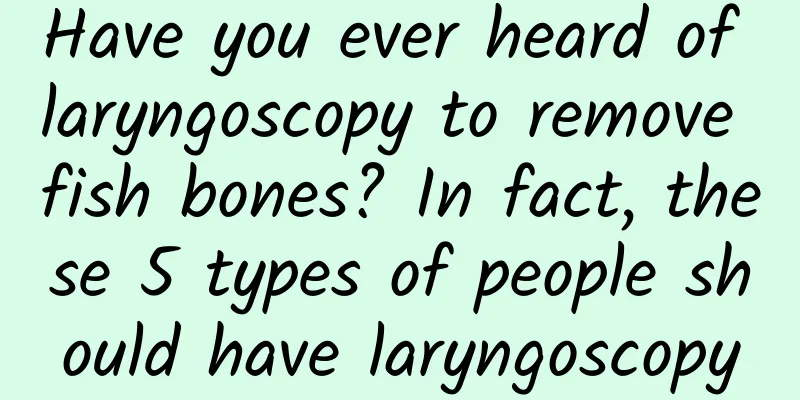Have you ever heard of laryngoscopy to remove fish bones? In fact, these 5 types of people should have laryngoscopy

|
Is there anyone around you? I got stuck eating fish It was taken out by laryngoscope Fishbone stuck Such a normal thing Why do we need a laryngoscope? Also , what exactly is a laryngoscope used for? What is a laryngoscope?Modern laryngoscopes mainly refer to electronic laryngoscopes, whose main advantage is that they can provide high-definition image quality and enhance detailed observation of pharyngeal structures. It can be imagined as "a slender camera" with a "light bulb" and a "small camera" with photographic function at the end, and a "steering wheel" at the near end. The doctor controls the direction of the mirror by "turning the steering wheel", so that it can move freely in the human throat cavity to diagnose and treat throat diseases. Why do you need a laryngoscopy when you have a fish bone stuck in your throat ?If you are stuck with foreign objects such as fish bones or other foreign objects, you should go to the hospital immediately for treatment. Do not try unscientific methods such as "drinking vinegar" or "sticking buns on the body". If the location of the foreign body is not deep and there is no obstruction, making it easy to operate, the doctor can easily handle it with tools; if the location is too deep, the shape of the foreign body is difficult to clamp, the patient cannot cooperate (such as a child), etc., then a laryngoscopy is needed. These 5 groups of people need laryngoscopyAs the name implies, laryngoscope is used to check "throat" problems. The following groups of people need laryngoscopy: 01 People with a history of head and neck cancer or digestive tract cancer: This group of people is at risk of developing pharyngeal cancer and should undergo regular laryngoscopy examinations. Patients with digestive tract cancer, especially esophageal malignancies, have a higher risk of developing pharyngeal cancer. In addition to regular gastroscopy examinations, they must also remember to undergo laryngoscopy examinations. 02 People with bags on their necks: Most of the neck lumps discovered accidentally are metastatic enlarged lymph nodes in the neck, which are very likely to be caused by the "migration" of primary tumors in the head and neck. Therefore, a laryngoscopy is needed in time to facilitate early detection of the primary lesion and a clear diagnosis. 03 People who smoke and drink for a long time: Studies have found that people who smoke and drink for a long time are not only prone to "damage the lungs" and "livers", but also prone to "damage the head and neck" and develop head and neck tumors. Therefore, they also need to include laryngoscopy in their physical examination list. 04 People who suspect a foreign object is stuck in their throat: Children and the elderly are prone to foreign bodies getting stuck in the throat, which can be a variety of small toys, fish bones, bones, and dentures. If a foreign body gets stuck in the throat, you should go to the hospital immediately. Most laryngoscopes can successfully remove the foreign body. Don't try to "drink some vinegar" or "stick some steamed buns in the throat". The former is proven to be ineffective, and the latter can cause the foreign body to get stuck deeper, with serious consequences. 05 People with throat discomfort: Symptoms of throat discomfort include hoarseness, foreign body sensation in the throat, throat obstruction, pain when swallowing, etc. These situations also require timely laryngoscopy, which can not only check and rule out the possibility of throat lesions, but also calm everyone's nervous "little hearts". What do I need to prepare before laryngoscopy ?You should actively communicate with your doctor before the examination. Do not conceal any simple medical conditions, medical complications, drug allergies, etc. Bring some previous relevant examination materials for reference. You generally do not need to fast before the examination, but you should also avoid eating too much or taking the examination immediately after a meal. What is the anesthesia method for laryngoscopy?When hearing about laryngoscopy, some people start to feel uneasy, "I may not be able to hold it in, and I am afraid it may get annoying." In fact, the laryngoscope is relatively slim, with the thinnest mirror having a diameter of only 2.6mm. It is relatively easy to perform examinations, and can usually be completed under local anesthesia. During the examination, the nasal cavity will feel a little swollen and painful. If you feel nauseous even when brushing your teeth, you may experience nausea in the throat, but most people can handle the examination under local anesthesia. In very rare cases where the throat reaction is severe or endoscopic treatment is required, the examination can be completed under intravenous anesthesia. How is laryngoscopy performed?Your throat looks like this. (Photo courtesy of the Endoscopy Department of Sichuan Cancer Hospital) Laryngoscopy can be performed while sitting or lying down. Generally, lying down is more comfortable, less stressful, and more convenient for the doctor to operate. The examination is usually performed through the nasal cavity. In some cases, it is necessary to conduct observation through the oral cavity to increase the scope of examination of the oral cavity and oropharynx and reduce the missed diagnosis of lesions. During the examination, you must exhale slowly and relax, which is conducive to completing the examination quickly and comfortably. During the operation, according to the examination part, you need to cooperate with the teacher to do some small movements, such as "close your mouth and exhale through your nose", "stick out your tongue", "make the sound of yi", "blow up a balloon", etc. These movements are conducive to revealing the throat and avoiding omissions. Is a biopsy taken during laryngoscopy ?If the doctor finds some abnormalities during the laryngoscopy, he or she will recommend taking some "small pieces of meat" for "testing" to help diagnose and rule out some special conditions. Of course, don’t have these kinds of thoughts: “I’m afraid of bleeding,” “It will hurt,” “They said it will move faster if it’s broken.” ... What are the precautions after laryngoscopy ?1. Laryngoscopy usually takes 2-3 minutes. If no anesthetic is used during the examination, you can eat after the examination. 2. If local anesthetic is used, you can eat in about 30 minutes ; 3. For some people with narrow nasal passages, the nasal mucosa may be slightly scratched, and there may be a small amount of nasal bleeding after the examination, which usually stops quickly. Avoid nasal bleeding immediately after the examination ; 4. Friends who have undergone biopsy will feel sore and uncomfortable in the throat after the examination, but generally no treatment is required and it will get better slowly. |
>>: Anesthetic management of intoxicated patients undergoing emergency surgery
Recommend
Pregnancy after three months of fetal arrest
If a pregnant woman's baby shows signs of fet...
Reasons for prolonged absence of menstruation
Period is a friend that every girl and woman enco...
Can I have sex during my 7th month of pregnancy?
There are many different opinions circulating amo...
What causes bloating in early pregnancy?
Many women experience stomach bloating in the ear...
How to remove makeup with cotton pads? What is the difference between makeup remover and makeup remover oil?
Today we will mainly talk about how to distinguis...
Pathmatics: European Social Media Advertising Report 2022
Instagram, Snapchat and TikTok are now available ...
Panic Attacks, Treatment and Awareness
introduction In daily life, we occasionally exper...
Which part of the stomach hurts when labor occurs?
There are many problems in the human body, and st...
Influenza virus is rampant, can we quickly develop immunity? How to improve immunity?
Image from: freepik.com Mycoplasma, influenza A v...
What to do if you have pharyngitis during breastfeeding
Pharyngitis is clinically called pharyngitis, whi...
Why does peanut oil have sediment? Why does peanut oil foam?
Peanut oil has a strong peanut flavor, and is ver...
Does pulling hair have any effect during menstruation?
It is not recommended for girls to do their hair ...
How long is the pregnancy?
Pregnant women will undergo various prenatal exam...
What is the cause of the small pimples on the vulva?
Modern women are busy with their family and caree...









